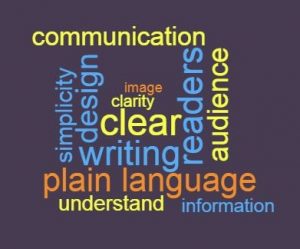Let’s be clear in higher ed communications
By Sharon Aschaiek | Oct. 10, 2018

This Saturday, Oct. 13 is International Plain Language Day. Established in 2011 by plain language advocates Cheryl Stephens and Kate Harrison Whiteside, it’s a day to mark the importance of reader-friendly, clear communication that is easy to understand. Stephens and Whiteside are also the founders of Plain Language Association International (PLAIN).
Most of us understand the logic of clear communication. Many countries, including Canada and the U.S., have enshrined plain language into law. International bodies such as the EU and UN have set standards for making information easy to understand. Legal and banking associations have taken similar steps.
Yet all too often, we see communication and marketing messages that are convoluted – full of jargon, technical terms, acronyms, the passive voice and otherwise vague or confusing language. Why?
Bad writing culprits
First, plain writing seems like straightforward, but any writer will tell you it’s actually harder to do than it seems. Other potential reasons include inadequate English education, and insufficient investment by companies in their employees’ communication skills.
Also, things tend to move fast in marketing departments, so there’s little time to refine messages. As well, the more relaxed writing standards on digital media, and the diverse standards for different social media platforms, affect how we communicate.

“Young people especially are doing much more writing than those in previous generations, and they have to navigate many more outlets geared to diverse audiences, so this creates new communication challenges,” says David Lipscomb, director of the Writing Center at Georgetown University, and a board member at large of the U.S.-based non-profit Center for Plain Language.
Achieving clarity
How can higher education communicators overcome these obstacles to achieve clarity in the marketing messages for their university or college? A good place to start is by keeping in mind the International Plain Language Federation’s definition of plain language:
“A communication is in plain language if its wording, structure and design are so clear that the intended audience can easily find what they need, understand what they find, and use that information.”
To apply that definition to your writing, consider the five key steps to plain language suggested by the Center for Plain Language, which I’ve summarized here.
1. Know your audience: Develop a solid understanding of the characteristics of your audience, what matters to them and what they want to learn.
“First and foremost, it comes down to audience — paying attention to who they are and what they think,” Lipscomb says. “Every editing decision should always come back to that priority.”
2. Structure it right: Organize the content in an easy-to-digest format. The information should flow in a logical order. Chunk content into short sections that have one distinct theme or idea. Use relevant, engaging headers and subheaders to explain upcoming information.
“Paying attention to structure is more important than ever now that we are all doing so much screen reading,” Lipscomb says. “Presenting information online effectively means having links, info boxes and infographics.”
3. Be conversational: Keep writing clear, concise and direct. Use short but logical sentences and include only relevant details. Put important information at the start of each section or paragraph. Use a conversational tone and strong verbs in the active voice. The goal is for the reader to understand the words and grasp the intended message quickly and confidently.
“I think in general, communication departments are much more aware of and focused on authenticity and using a conversational tone in their communications,” Lipscomb says. Looking at the landscape of communication at Georgetown, he says he has noticed gaps in how some academics communicate about their research, and in how information about IT security is communicated internally.
4. Be design wise: Use graphic and web design principles appropriately to best convey information. That means making good use of headers and sub-headers, typography, white space, photos and graphics. The design is effective when it helps users efficiently move through the information.
5. Test it out: Evaluate the effectiveness of your content and design by getting input from target user groups. Test for areas such as relevance to audience needs, clear organization of content, readability and understandability.